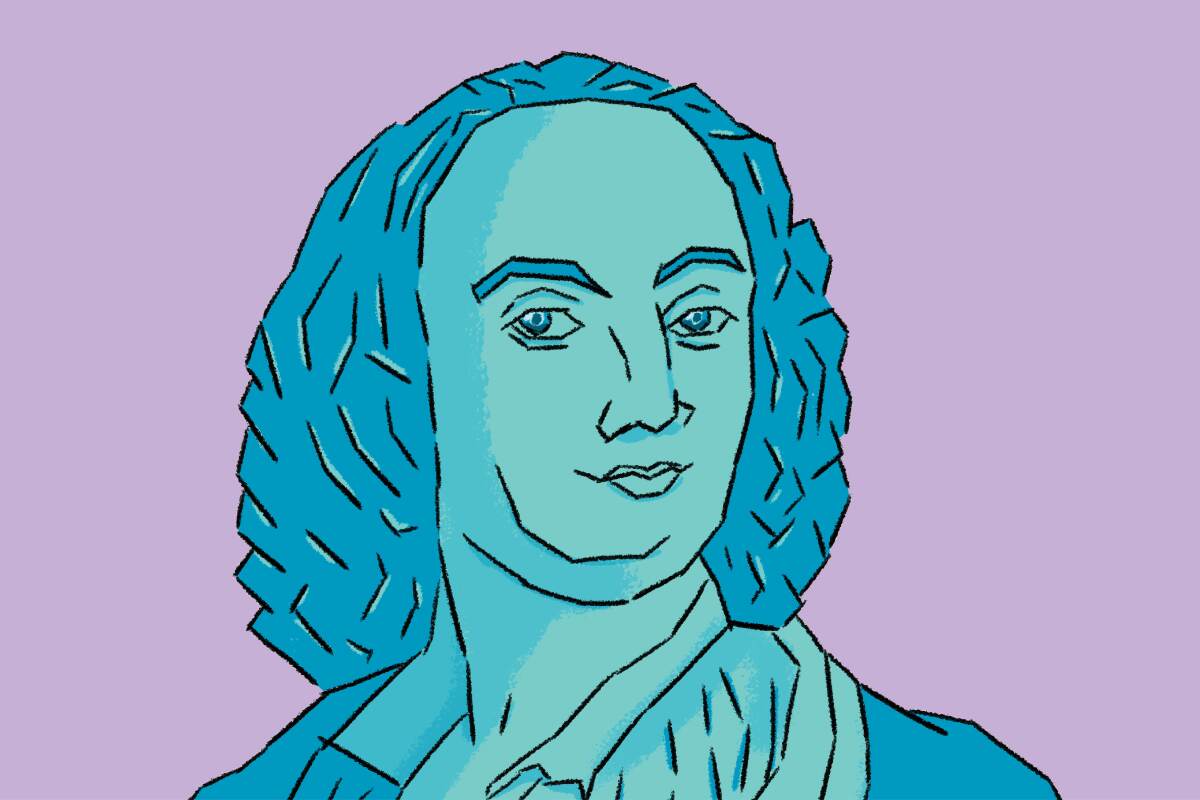Machaut’s ‘Notre Dame’: Why a 14th century mass is the genesis of modern music

- Share via
How to Listen: Machaut’s “Messe de Notre Dame”
Travelogue DVDs are the favored entertainment in my dentist’s office during teeth cleaning. Once, as I was distracting myself by following a helicopter tour over the historic Notre-Dame Cathedral in Reims, France, the buzz of the polishing device triggered a vividly ringing performance, inside my head, of the opening of Guillaume de Machaut’s “Messe de Notre Dame,” which he wrote for this great Gothic space.
The mass features four male voices in open harmonies capable of amplifying mystery in the cathedral’s magnificent open spaces, a sound once heard and likely never forgotten. Swirling melodies liquefy the architecture. Incense-worthy harmonies imprison the senses. A mass of Marian devotion, Machaut’s “Messe” has strains of an amorous love letter to the Virgin Mary, as irresistible as it is shocking.
This is a one-of-a-kind mass, written probably around 1360, only a few years after the Black Death, when bubonic plague reduced the population of Reims by a quarter to a third, as it did most of Europe. The Hundred Years’ War between England and France had been raging for more than two decades. Yet there was, in this so-called calamitous century, beauty and innovation that has lasted, with unvarnished relevance, for hundreds of years more. In many ways, Machaut serves as the starting point for the modern idea of music.
Music was around, of course, before Machaut. The curtain goes up in Richard Taruskin’s monumental, five-volume Oxford History of Western Music with 8th century chant. In “A Million Years of Music,” Gary Tomlinson makes the case for patterning behaviors in our hominin ancestors 800,000 years ago being precedent for “modern musicking.” And the dinosaurs beat us to that 200 million years earlier, at least in “Jurassic Park.”
But it is only in the two centuries before Machaut that we can begin assigning modern sounds to old music and the personality of two composers who continue to entrance modern ears. Hildegard von Bingen’s 12th century chants have proved marvelous enough to make the mystical abbess cult-worthy. Pérotin’s rhythmically striking chants influenced Steve Reich’s early minimalism. During these two centuries, polyphony slowly arose to glorify sacred spaces. Troubadours and minnesingers created a new popular musical culture, as did instrumental dance music.
Yet Von Bingen or Pérotin remain historical curiosities. It is with Machaut that the looking-back stops. You don’t need to be told how to listen to the “Messe de Notre Dame.” In it, Machaut seems to have almost had his finger on our pulse.
There is a flowing character in which solemn melody blossoms almost like the blues (and, yes, there are blues, as well as folk and jazz Machaut covers, to say nothing of heavier metal). His modal harmonies are ones we hear all the time. When Beethoven used the Lydian mode in his Opus 132 string quartet, the previous work in our How to Listen series, he was specifically evoking an all-but-forgotten past. But once modal music became newly adopted by Debussy, Bartók and other 20th century composers, it never left us.
Ecstasy and excess, rhythm and repetition, gender and ethnicity. Lyricism, protest, healing. Critic Mark Swed’s series on the ideas embedded in every note.
Most of all, though Machaut’s “Notre Dame” represents the first great example of one of the most familiar and significant genres of Western music. The mass, as a musical composition, has long transcended specific liturgical intent. This central rite of the Catholic Church has remarkably wound up having a central place in the development of Western music, adaptable to any and all musical styles and occasions. It serves spiritual practices and perspectives far removed from Roman Catholicism. There is simply no way to think about classical music without Bach’s Mass in B Minor, Beethoven’s “Missa Solemnis,” Janácek’s “Glagolitic Mass,” Stravinsky’s Mass, Leonard Bernstein’s “Mass,” to say nothing of the eternally timely requiem masses by Mozart, Berlioz, Brahms, Verdi, Faure and Ligeti.
Machaut’s is the first mass by a single composer. It is also the first to fully incorporate styles of other genres, such as motet and song yet retain an overriding unity and personality. Machaut’s great achievement is to humanize the mass to such an extent that its specific sections of Kyrie, Gloria, Credo, Sanctus and Benedictus, and Agnus Dei come to be heard as universalized glorification of goodness, as pleas for peace and goodwill for all.
The means of doing this for Machaut were hardly of his own devising. For all the awfulness of his time, the 14th century gave us the first institutionalized avant-garde in music. Thanks to the Ars Nova, once forbidden and still disapproved of dissonances added expression in melodies. Rhythms gained mathematical complexity, as theorists demonstrated ways of creating contrapuntal structures based on square roots and cubing numbers. Difficult to discern repeated rhythmic patterns, part of a process called isorhythms, underscored freer flowing melodies, full of hiccuping syncopation (called hocket).
In Machaut’s Kyrie, where there is little text, rigorous formalism is the guiding principle. In the Gloria and Credo, much Latin must be set, and here the style changes to dramatic musical description peppered with moments of stunning gravity, such as when everything stops for grounding on the words Jesu Christe. The Sanctus ends with a rapt, unstoppably knock-em-dead Amen, beginning the challenge for composers to outdo one another with their Amens. The minutiae in Machaut’s “Notre Dame” are more plentiful for most ears, just as the decorative details in Notre Dame’s Gothic design are for eyes of a visitor to Reims.
For me, seeing this magnificent cathedral, where kings had their coronations, from a dentist chair gave it a wholly unexpected novel perspective. But then every time the “Messe de Notre Dame” comes upon us, the perspective changes. Performance styles vary greatly. Most of the historically minded do it with just four singers, but some go for a chorus, and some add instruments.
Coronavirus may have silenced our symphony halls, taking away the essential communal experience of the concert as we know it, but The Times invites you to join us on a different kind of shared journey: a new series on listening.
Imaginative musicians do whatever strikes them. You can find arrangements of the mass for viola and accordion. The Kronos Quartet scatters a string quartet arrangement of Machaut’s Kyrie throughout its 1997 “Early Music” album. Jeremy Denk begins his latest piano recording with Machaut. Roland Hayes brought the same resounding brilliance to Machaut that he did to African American spirituals. Don’t miss the “sick black metal” Machaut of a group called Sühnopfer.
Messe de Notre Dame ends with what should be the appropriate inevitability of its final section, “Ita Missa Est” (Go, the Mass Is Ended). It lasts less than a minute and is utterly, dancer-ly joyous. No solemn processional this, but a swift kick in the pants to get out into the world and live. Machaut, the latest musicological research tells us, meant his mass as memorial for himself. What a way to go.
Starting points
There have been somewhere in the neighborhood of 40 recordings of “Messe de Notre Dame,” beginning with excerpts made 1935, endearingly sung as though perfumed Poulenc.
The Hilliard Ensemble gave us a marvelously clean and pure 1987 performance that has the flavor of modern music.
The Orlando Consort recording from 2008, “Scattered Rhythms,” features the mass made deliciously ripe and plumy and placed with gorgeous contemporary works by Tarik O’Regan and Gavin Bryars.
The Belgian ensemble Graindelavoix lives up to its name in a recent revolutionary version, adding aggressive vocal grain and wild ornamentation that turns “Messe de Notre Dame” into a kind of transgressive folk music, which, for all we know, may be just what the 14th century Reims avant-garde was all about.
Look for future installments of this series on Wednesdays at latimes.com/arts, and support this work and The Times’ other arts coverage with a digital subscription.
More to Read
The biggest entertainment stories
Get our big stories about Hollywood, film, television, music, arts, culture and more right in your inbox as soon as they publish.
You may occasionally receive promotional content from the Los Angeles Times.













